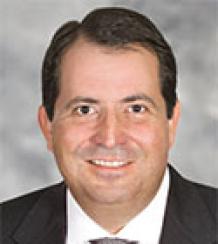To view a PDF of the report, click here.
Insurers’ desire for specialized expertise and better portfolio performance drives an outsourcing trend.
By Richard Westlund

| ||
| David Holmes, partner, Eager, Davis & Holmes | Ken Griffin, managing director and head of insurance solutions, Conning | Don McDonald, president and CEO, Prime Advisors |
| “You have to build a relationship and understand the insurer’s situation before you can talk about a solution. That doesn’t happen overnight.” | “Changes [to NAIC risk-based capital guidelines], which are expected to take place at the end of 2017, provide an incentive for insurance companies to seek out the highest-rated securities in the corporate bond market as well as the structured-securities market.” | “Asset managers need to understand [the client’s] profile, develop investment guidelines and create benchmarks that reflect the company’s liability and business operational requirements.” |
“Outsourcing has grown steadily in recent years, particularly for specialty asset classes,” says Stewart Foley, partner at Insurance AUM, which provides guidance for asset managers seeking to serve the insurance market. “When it’s difficult to find the right investment expertise inside an insurance company, it makes sense to engage third-party managers to gain effective exposure and expert investment capabilities.”
An October 2015 survey by the Insurance Asset Outsourcing Exchange identified several key reasons insurers outsource asset management services (see chart, page 3). A desire for expertise not available in-house and a desire for specialized strategies topped the list.
Richard Sega, managing director and chief investment officer at Conning, says the trend to diversify sources of income and return spans insurance companies of all sizes. “When rates were higher in the past, insurance companies were usually able to generate enough income from high-grade fixed-income securities in their general accounts,” he says. “But with rates near zero, those mandates have broadened away from core fixed-income as insurers look for returns outside the traditional channels.”
While insurers usually have an in-house fixed-income team, many have found it hard to create capability in other asset classes, which require expertise and scale, says Foley — hence the search for the right outside providers.
Understanding the industry
To succeed as investment service providers to the insurance industry, however, asset managers need to understand the nature of the business and its particular needs. That includes the regulatory environment and how different insurers fund their operations. “You have to build a relationship and understand the insurer’s situation before you can talk about a solution,” says David Holmes, partner at Eager, Davis & Holmes. “That doesn’t happen overnight.”
“Insurers are leveraged, long-funded, with liabilities through the economic cycle, heavily regulated and challenged by their contingent liabilities, whose timing and amount are uncertain,” says Sega. “Because of the need to protect their surplus, insurance companies tend to be fundamental investors that are risk-averse, with long time horizons.”
From the insurer’s perspective, successful asset management has two aspects, says John Simone, senior vice president and head of insurance solutions at Voya Investment Management: “They want consistent performance without surprises, and operational support, including reporting and back-office services. Both of those aspects need to be coordinated smoothly by the manager.”
Because insurance companies typically follow a buy-and-hold strategy, they want to minimize downside risk through strong credit or investment underwriting by the asset manager. “As insurance companies seek to dial up their risks in a regulatory-rich environment, they need to be able to understand the sources of return in a highly transparent manner,” says Simone.
Their risk guidelines may be changing too — another thing asset managers will need to track. The National Association of Insurance Commissioners (NAIC) is crafting a revised formula for risk-based capital that would group securities into three different categories based on their credit ratings. “Those changes, which are expected to take place at the end of 2017, provide an incentive for insurance companies to seek out the highest-rated securities in the corporate bond market as well as the structured-securities market,” says Ken Griffin, managing director and head of insurance solutions at Conning.
Sega adds that it may take a while for insurance companies to get their internal risk monitoring and compliance procedures in place for alternative assets. Some are taking a “toe-in-the-water approach” before making a larger commitment.
Although managing risk is critically important for all insurance companies, each one has a unique risk profile, according to Don McDonald, president and CEO of Prime Advisors, an affiliate of Sun Life Investment Management. “Asset managers need to understand that profile, develop investment guidelines and create benchmarks that reflect the company’s liability and business operational requirements,” he says.
That profile, and its own internal capabilities and needs, will drive each company’s specific requirement for outside managers. One insurance company might want a fixed-income partner to supplement its in-house team, Foley notes, while another might seek out a manager in a particular asset class, such as municipal bonds. Other companies could engage a service provider for enterprise risk management analysis, business modeling or investment accounting or statutory reporting services. “Outsourcing in the insurance world is not driven solely by performance, which is why this market differs from others,” Foley says.

| 
| |
| Richard Sega, managing director and chief investment officer, Conning | John Simone, senior vice president, head of insurance solutions, Voya Investment Management | Stewart Foley, partner, Insurance AUM |
| “With rates near zero, [fixed-income] mandates have broadened away from core fixed-income as insurers look for returns outside the traditional channels.” | “[Insurers] want consistent performance without surprises, and operational support, including reporting and back-office services. Both of those aspects need to be coordinated smoothly by the manager.” | “Outsourcing has grown steadily in recent years, particularly for specialty asset classes.” |
Over the past five years, core fixed-income has held the largest share of outsourced mandates, followed by specialized fixed-income roles, according to a recent study by the Insurance Asset Outsourcing Exchange (see chart, below left).
This reflects the dominant elements in most insurers’ portfolios — typically, high-grade fixed-income securities such as government and corporate bonds, according to Holmes. But the flattening of the yield curve has reduced some of the premium on long-duration fixed-income assets. “Therefore, insurance companies are looking at lower-rated credits, where they make sense, including higher-yield emerging-market debt,” Griffin says.
Within the fixed-income space, McDonald has seen a slight increase in high-yield allocations. “Unfortunately for many managers, that has been the result of downgrades in the energy sector,” he adds. “However, high-yield has performed very well so far this year.”
Some insurance companies that pay taxes are increasing their allocations to tax-advantaged municipal bonds, which have been total-return leaders in fixed income over the past few years, McDonald says. ““It is important to have a manager who conducts extensive research and focuses on high-quality municipals rather than simply chasing yield,” he notes. “Investors who purchased Puerto Rican bonds have learned the hard way.”
Duration risk is another consideration. Today, there is tremendous global demand from pension funds, insurance companies and other institutional investors for intermediate and long-term fixed-income products, says McDonald. “Since every new insurance premium has a longer duration than existing premiums, our stance has been directed toward full-duration fixed-income products for client portfolios,” he says.
Insurers’ interest in securitized credit such as commercial mortgage-backed securities (CMBSs) continues to increase, notes Simone. “These credits were put on the books because they have a lower correlation to interest rate and spread risks,” he says. “Securitized credits also allow investors to make a pure play on the U.S. economy because we have such a well-developed mortgage market.”
Diversifying their strategies
Along with higher-risk fixed-income classes, many insurers are increasing their allocation to equities, real estate and alternative assets. Equity products have generated greater total return than fixed-income over the past few years, McDonald says, while “real estate is also getting more attention, as this asset class has also performed well.”
In the equity sector, insurers are attracted to high-dividend strategies that produce a cash flow, rather than approaches that focus on potential appreciation or an absolute-return objective, says Simone. Some insurers prefer a quantitative approach, he notes, such as using lower-cost index or exchange-traded funds (ETFs), while others focus on fundamentals with an active manager. “An asset manager can also combine these approaches to deliver a customized solution to the client,” he says.
Property and casualty (P&C) companies are seeking exposure to equities, floating-rate credit, commercial real estate and venture products as well as private equity, private debt and hedge funds. However, those allocations are usually relatively small compared with core fixed-income.
Insurers are also expanding their mandates globally, investing in both developed and emerging markets around the world.
“If the insurance company expands the mandate to a global level, an asset manager can get even more diversification for the portfolio,” says Simone, adding that there are many fixed-income issuers in the G7 countries as well as opportunities in private placements.
Insurance companies from low-yielding regions such as Asia are investing in North America in search of higher yields, Griffin notes. But the downside of international strategies is exposure to currency fluctuations. And even though hedging can minimize that risk, some insurers prefer to avoid currency exposure entirely.
Balancing liquidity options
Understanding their liquidity requirements creates the opportunity for insurers to increase allocations to private placements, commercial mortgages and other alternatives that may offer a premium over more liquid investments.
“Illiquid classes can provide additional yield and a wider set of investment opportunities,” Griffin says. So popular have these investments become within the insurance industry that these buyers have been instrumental in a recent tightening of the illiquidity premium.
By providing capital to companies through private placements, insurers are performing an important service while creating opportunities to enhance their returns. Life, health and P&C companies typically have a significant segment of their portfolios allocated to private placements, says Simone.
However, Griffin emphasizes the importance of conducting a thorough analysis of the insurer’s liquidity needs, including stress-testing and stochastic analysis — particularly when investing in private placements or other illiquid classes “So you know you could raise cash if necessary,” he adds.
“It’s a common myth that making money in private placement securities is based on the discount,” Simone says. “But a really good limited partner interest won’t trade at a discount without highly motivated sellers. In other words, you can get a lousy company on the cheap, but if you want to get quality, you need to look beyond the discount.”
Best practices for insurers
Before expanding a mandate or allocating to new asset classes through a new outside manager, Sega says, insurers need to take a careful look at their current portfolio mix. “Because of the tax and accounting regulations, it can be hard to make big changes quickly,” he says. “Consider making the initial changes with the company’s marginal cash flow to avoid disruption to other parts of the business. That allows an asset manager to put the strategy into play quickly but not at the expense of a rating change.”
With hundreds of asset management firms competing for insurance company mandates, a “cookie-cutter approach” doesn’t work, McDonald says. “It takes a dedicated team to build relationships and develop appropriate customized strategies. We believe the future of the industry is based on a high level of service, economies of scale and the ability to deliver a full asset management solution in addition to delivering good investment performance.”




